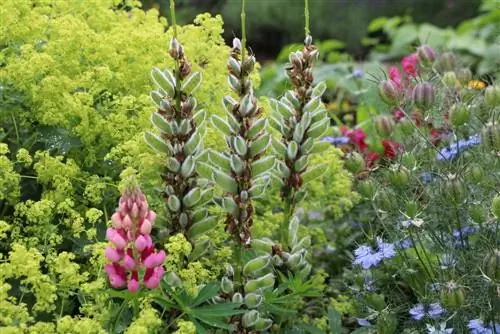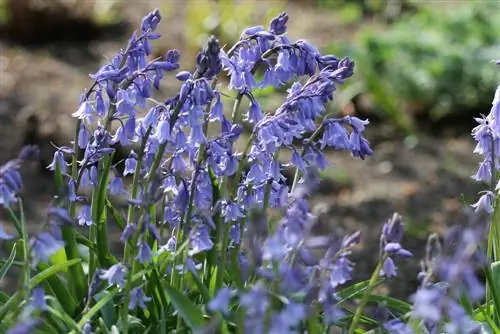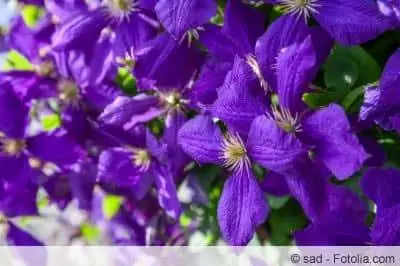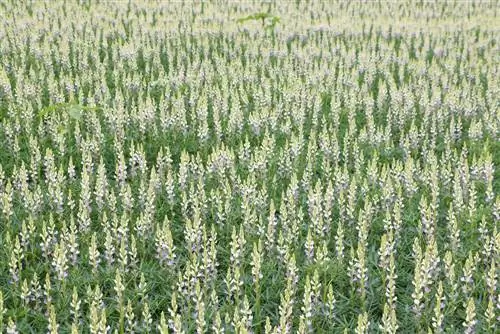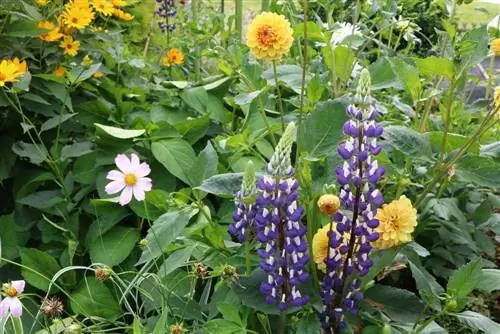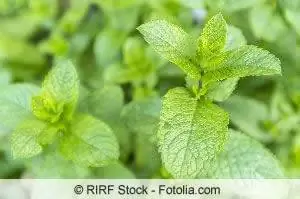- Author admin [email protected].
- Public 2023-12-17 03:39.
- Last modified 2025-01-24 12:45.
Once a typical classic on farms, their rural charm now makes lupins a popular perennial in urban areas, where they add summer accents with lots of color. Since it is relatively frugal when it comes to care, it doesn't require much of your time. In the following guide you can find out everything about it, as well as about propagation, overwintering and much more.
Location
Your demands on the location, which determines how strong, lush and flowery lupins thrive. To create optimal conditions, the location should meet the following criteria:
- Lighting conditions: sunny to partially shaded
- Around four hours of sunlight a day is optimal
- Sheltered from the wind but airy location
- Loves warmth
- Gets along very well with plant neighbors
- As soil improvers, plant neighbors enjoy their presence
- It feels just as comfortable in a perennial bed as it does in a pot
Soil texture
Lupins have the ability to improve soil conditions. Their long roots loosen even compacted soil. Nevertheless, she likes the following soils:
- Loose, deep earth
- Sand mixed into heavy soils makes them grow denser
- Water-permeable soils that do not become waterlogged
- limestone
- moderately nutritious
- pH value: between 5.0 and 6.0
Substrate
If the lupine is planted in a pot, make sure that a high-quality substrate is used instead of cheap, conventional potting soil. This usually compacts very quickly and the risk of waterlogging and mold formation is high. A substrate that is particularly permeable to water is ideal. Perlite loosens the substrate. Coconut fibers ensure good water storage without causing waterlogging. A low sand content can be included as an alternative to coconut fiber. Otherwise, the substrate should have the same properties as previously described for garden soil.
Best planting time
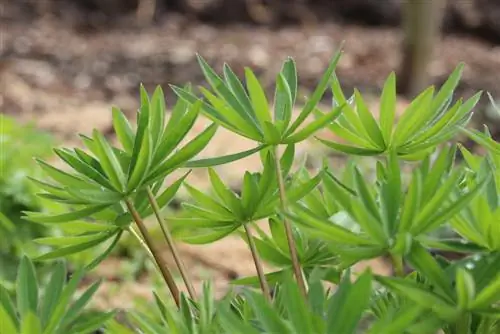
Flowering perennials generally have the best planting time in early autumn. This gives them enough time to get used to their new surroundings and, above all, to establish their roots. Planting in autumn promotes flower formation the following year. It is important to ensure that the first frost is not expected after planting.
Advanced Lupinus
If lupins are preferred, they can still be planted in spring. Mid-May is a suitable time. The ice saints must be waited out so that the plants are not exposed to frost after spending the winter in warmer surroundings.
Plants
Garden bed
- Soak the root ball in a bucket of water for about ten minutes to make it easier to remove it from the pot
- Dig a planting hole that is twice as big as the root ball
- Ideally, lay a two centimeter thick drainage made of a layer of quartz sand or gravel on the ground
- Place the plant in the middle of the planting hole and close the hole with the excavated soil
- Press the soil lightly on the surface
- Pour moderately
- Planting distance: between 30 centimeters and 50 centimeters
Bucket
When cultivating in a container, proceed as described under “Garden bed”. You should use a container that is large enough so that there is at least eight to ten centimeters of space between the side root ball and the container walls. Above all, there must be an appropriate depth so that the roots develop well and the perennial can grow optimally.
The substrate surface should be at least two centimeters away from the edge of the bucket so that any silt does not spill over after watering. A drainage hole in the bottom of the bucket allows excess water to drain away and prevents waterlogging.
Pouring
Planted in the garden soil, adult lupins generally do not require any irrigation water. They have deep roots and draw the moisture they need from the depths of the soil. Watering is only carried out when there are long dry periods. Young plants in their first year of life and specimens grown in containers need to be watered occasionally. When they are still young, they do not yet have a deep root system. In a bucket, a Lupinus does not have the opportunity to independently supply itself with water from the ground. Watering is done before the soil/substrate dries out on the surface. Here the thumb test helps to find the optimal time:
- Keep your fingers crossed in the soil/substrate surface
- If it can be indented less than two centimeters: watering requirements
- If it can be pressed deeper than two centimeters: no watering required
Fertilize
Lupins like soil that is not very nutritious and they cannot tolerate lime in large quantities. They produce nitrogen themselves through small nodules that grow on their roots. Therefore, fertilizing is not absolutely necessary. If you still want to fertilize, you should limit yourself to mature compost. This can be administered at the start of the official gardening season in May. Fertilization should be avoided in autumn as the wolf bean has to prepare for overwintering and slowly goes into rest mode. Fertilizer would disturb them. In principle, young plants should not be fertilized in the first year of life.
Cutting
In principle, cutting is not necessary for lupins. Nevertheless, it can make sense and can support the perennial, especially in the formation of flowers, and promote dense growth. The following procedure/cutting methods are recommended:
- Cut off the panicles after flowering - this increases the chance of a second flowering in late summer/early autumn
- If propagation by self-sowing is not desired, the panicles must be cut off after flowering
- In autumn, pruning to a height of ten centimeters promotes dense growth in the following year
- Pruning can also be done in spring, but this could result in delayed flowering
Wintering
Lupinus, depending on the variety, show a winter hardiness of up to minus 25 degrees Celsius if they are planted in garden soil. As deep-rooters, the roots reach a depth of around 1.50 meters. There they are well protected from the icy cold and for this reason do not need winter protection. This looks different with specimens in pots. Thanks to the thin container walls and bottoms, the cold reaches the roots almost unhindered. Symptoms of frostbite are not uncommon. With the following measures you can protect yourself from the cold so that you can survive even the coldest winter without any problems and without damage:
- Place an insulating base such as Styrofoam, wood or cardboard under the bucket
- Cover the substrate surface thickly with straw, leaves or pine needles
- Wrap the bucket walls several times with fleece or foil
Propagate
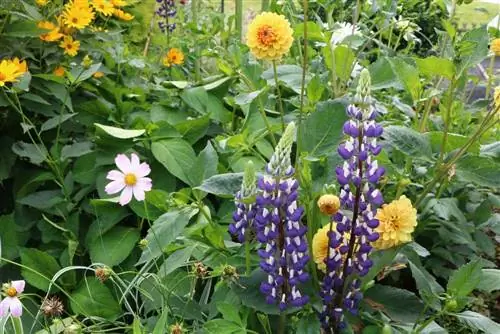
Although the lupine can reproduce independently through seeds, many hobby gardeners prefer controlled propagation - especially since you can also determine the color of new plants in this way. Propagation can be carried out in various ways and does not require any special skills or knowledge.
Sowing
You have the option of obtaining seeds from a lupine or buying them from specialist retailers. With the seeds from a lupine you have no influence on the flower color. There are all sorts of colors to choose from when buying seeds. The seeds of a lupinus are ripe when the pods are completely dry and grayish-brown in color. You can choose between different sowing methods.
Instructions for sowing beds
- Best time to sow: between May and August
- Best location: sunny and warm (no direct sun)
- Dig the soil deep and loosen it well
- Remove weeds, old root residues as well as stones and everything else that doesn't belong in the ground
- Enrich the soil with compost and horn shavings and mix well
- Spread seeds over the soil and cover about one to two centimeters with soil
- Seed spacing: approx. 30 centimeters
- Spray the soil generously with water (do not use a watering can as the seeds could float away)
- Put transparent film over the seeds (increases the chance of germination)
- Open the foil every two days to ventilate and moisten the soil (daily on hot days)
- Germination usually occurs after a few days
- Remove the film from the first leaf growth and allow the soil to dry slightly before watering
Instructions for sowing in the house/greenhouse
Sowing in greenhouses or in the apartment is basically the same as when sowing in the garden bed. Only the following different factors should be taken into account:
- Best time for sowing: all year round
- Soak seeds in water between twelve and 24 hours before sowing
- Use potting soil or a peat-sand mixture
- Softened seeds are pressed about one to two centimeters into the substrate/soil
- Location: bright, warm window seat without direct sunlight
- Avoid dry heating air
- Prick out when the first leaves appear
Cuttings
- Best time: Spring
- Choose suitable cuttings from the middle stem area
- Length of suitable shoots: between ten and 15 centimeters
- Cuttings should have four to six leaves
- Separation from the mother plant occurs approximately 0.5 centimeters below one eye
- Cut the lower leaves in half with a sharp knife
- Remove any buds and flowers
- Put half of the cutting into a flower pot with potting soil or nutrient-poor substrate
- Water well and continually keep the soil moist without overwatering
- Location: by a bright window
- Optimal ambient temperature: 20 degrees Celsius to 25 degrees Celsius
Tip:
A transparent plastic cover placed over the plant increases the chances of roots forming quickly. This must be removed again after the first leaf growth.
Diseases
Lupins are very robust against diseases. This is usually due to care errors such as too much water or fertilizer. If the perennial is permanently too wet, root rot can quickly form. Since these are deep in the ground, digging them out without damaging the roots is almost impossible. Here you can only hope that a longer water break will enable recovery.
If there is an oversupply of fertilizer, this is usually reflected in yellow discoloration, decreasing stability and premature wilting of flowers. In any case, further fertilization should be avoided and you can only hope that the perennial will recover again.
Leaf shedding disease (Stemphylium spp.)
This is a fungal infection that tends to cause lupins to become ill at temperatures above 15 degrees Celsius and high humidity for more than twelve hours.
malicious image
- Small, round-shaped, gray-blue to gray-brown spots on the leaves
- Red-brown spots on stems and pods
- Increased leaf drop
- Rotten cone of vegetation
- Plant dies if left untreated
Combat
As leaf shedding disease can progress quickly, rapid use of a fungicide is recommended.
Pests
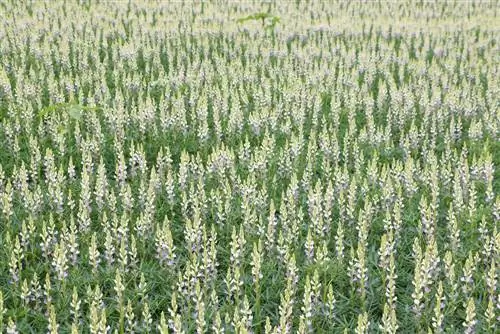
The wolf bean is also very resistant to pests. The most common is the lupine aphid.
Lupine aphid
Detection and malicious images
- Size: approximately three millimeters
- Body color: green, brown, transparent, brown-black
- Mostly sit on the underside of the leaves
- In colonies they often gather on the stems
- Sticky coating on the leaves (honeydew)
- Yellow spots form at the puncture sites where they have extracted plant sap
- Growth disorders
- Buds don't open
Combat
With a minimal infestation, it is often enough to get the lupine aphid off the perennial with a strong jet of water. Otherwise, a strong soap solution has proven to be excellent against the pests:
- Soft soap is best for the lye
- Pour plenty of it into clear water and mix well
- The lye should be relatively highly concentrated (water very cloudy due to the soap)
- Pour soapy water into a spray container
- Spray lupine generously on the undersides of the leaves too
- Repeat the process every other day if necessary

